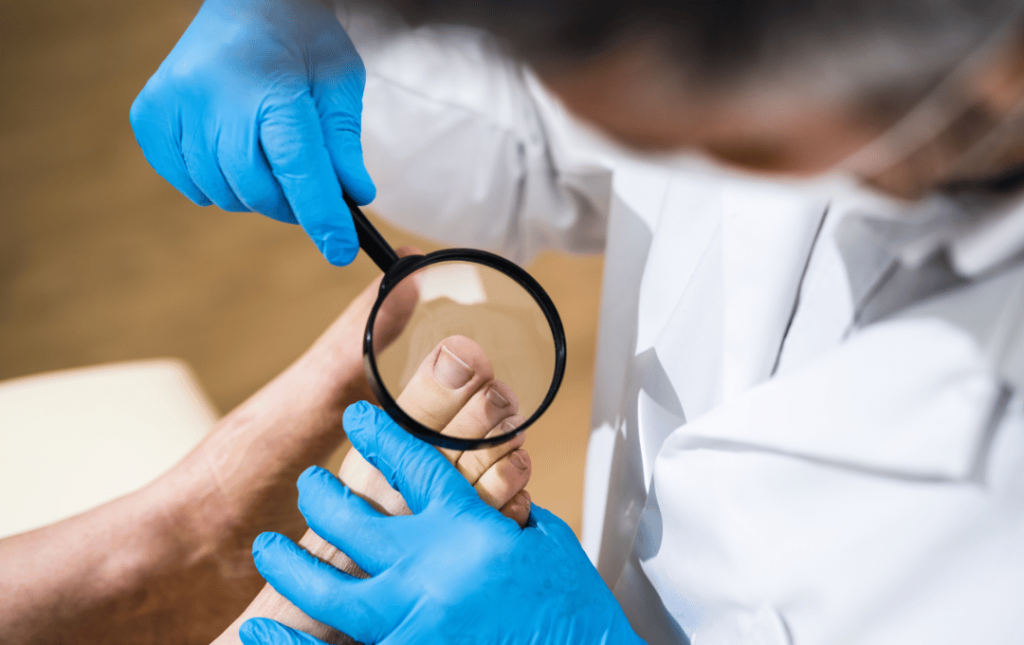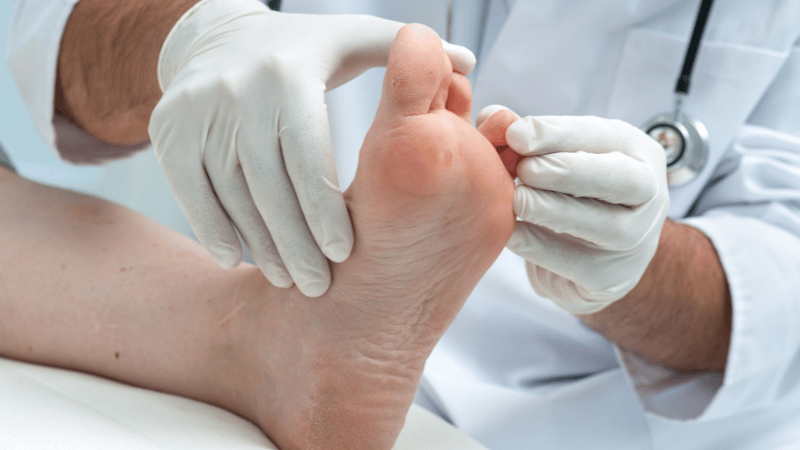If your toenails aren’t growing, the cause can range from common, minor issues like a fungal infection or physical trauma to the nail bed to more serious underlying health conditions like poor circulation. Poor circulation can limit the flow of blood, oxygen, and nutrients, which are essential to proper toenail growth.
In many cases, slow nail growth can be expected with aging or recent foot trauma. However, when toenail growth stops completely or slows significantly, it can signal a lack of essential nutrients and oxygen reaching the nail, often due to a vascular issue that impairs circulation, such as peripheral artery disease. Peripheral artery disease is a serious vascular condition characterized by the buildup of plaque in the arteries. When left untreated, it can cause the toenails to stop growing completely.
Explore the causes below to determine if your symptoms require a visit to a specialist.
How Fast Should Toenails Normally Grow?
Toenails grow an average of 1-2 mm per month. To help you visualize this, a single dime is approximately 1.35 mm thick. So, over an entire month, your toenail grows a new length that is about the thickness of a dime. Changes in nail length and growth rate can vary depending on internal and external factors.
Nail growth can vary between different seasons or climates. Nutrition, age, and hormonal imbalances can also lead to slower toenail growth. Many individuals may only notice small, subtle changes in toenail length, which is why changes can easily go unnoticed. If your toenails stop growing completely, it could be a symptom of a more serious issue.
Common Reasons Toenails Stop Growing or Grow Slowly
There are several reasons, both serious and non-serious, why toenails may stop growing or grow more slowly. Some common reasons include:
Poor Circulation
Poor circulation can limit the flow of blood, oxygen, and nutrients to the toenails. This is a common symptom of vascular conditions, including varicose veins, blood clots, atherosclerosis, and peripheral artery disease (PAD).
Trauma to the Toenail
Stubbing a toe or dropping something heavy on the toenail can cause toenail growth to slow or completely stop. Nail growth typically resumes after the injury heals.
Fungal Infections
Fungal infections affect the nail bed, causing brittle nails or changes in nail color. These infections require antifungal medication to promote the regrowth of the toenails.
Nutritional Deficiencies
A diet that lacks iron, zinc, or vitamin B can also lead to slow nail growth. These are nutrients the body needs to create keratin, a key component of healthy nail growth. Nutritional deficiencies can also cause nail brittleness, skin issues, and hair loss.
Aging and Natural Changes
Blood flow and circulation may slow with aging. This means fewer nutrients reach the toenails, slowing nail growth. After age 25, the growth rate generally slows by about 0.5% each year.
When Toenail Changes Signal a Vascular Problem
While trauma or fungus are common causes, persistent lack of growth, especially if accompanied by leg pain, numbness, cold feet, or skin discoloration, is a critical sign of poor circulation and warrants a vascular screening.
How Poor Circulation & PAD Progression Impacts Toenail Health and Growth
Poor circulation in the lower extremities can severely inhibit hair and nail growth. The nail bed is supplied with nutrients by tiny blood vessels and requires adequate oxygenated blood from the leg’s arteries for continued nail growth.
With poor circulation, toenails may appear more brittle, pale or bluish in color, or thicker. Toenail growth on one foot is slower than on the other. When circulation is severely compromised, the toenails may stop growing completely. One of the most common causes of poor circulation is peripheral artery disease (PAD).
PAD is a serious vascular condition caused by plaque accumulation in the arteries. When the plaque builds up, it restricts the free flow of oxygenated blood to your lower extremities, which can cause leg pain, poor wound healing, and slow toenail growth.
If you’re experiencing poor circulation, take our online risk assessment quiz to see if you are at risk for PAD.
Signs of PAD That May Accompany Nail Changes
Individuals who are diagnosed with PAD or a serious vascular condition may experience other symptoms besides slow or non-existent toenail growth. Some common PAD symptoms include:
- Cold Feet and Toes: Cold feet and toes are common signs of poor circulation or arterial blockage, often accompanied by tingling or numbness.
- Discoloration of Toenails: Nails with a yellow or brownish tint can be caused by poor circulation. Individuals might also notice shiny, dry skin on their legs or pale or blue-colored toes.
- Pain in the Feet: Aching, tingling, or cramping in the legs during light activity, which is relieved by rest, may indicate intermittent claudication, a key symptom of PAD. If PAD progresses to critical limb ischemia (CLI), pain may persist when resting.
Poor toenail growth can be a sign of moderate to severe PAD. If your toenails have stopped growing, don’t wait for your symptoms to worsen. Consult a specialist at USA Vascular Centers if you’re experiencing any of the symptoms above.
MEET WITH A VASCULAR SPECIALIST
When to See a Doctor for Toenails That Aren’t Growing
If you’re experiencing slow toenail growth with other risk factors or symptoms, a vascular screening can provide an accurate diagnosis and treatment plan. If a vascular specialist determines that peripheral artery disease is the reason your toenails stopped growing, a non-invasive treatment may be recommended to slow the progression of the disease.
Early treatment can effectively manage PAD symptoms and prevent further health complications, and ultimately improve quality of life.
At USA Vascular Centers, we offer three non-invasive PAD treatments:
- Angioplasty: A tiny balloon is inflated to open the artery and compress the plaque against the artery wall.
- Stent Placement: Following an angioplasty, a mesh stent may be placed in the area to prop the artery open.
- Atherectomy: Accumulated plaque is safely removed from the arterial walls using a thin tube with a specialized tip.
In conjunction with treatment, the vascular doctor may recommend diet changes or physical activity to help manage symptoms. Although lifestyle modifications can relieve some discomfort associated with PAD, they are not a standalone solution without treatment for addressing a serious vascular condition.
Restoring Toenail Growth With Help From USA Vascular Centers
Toenail growth is generally a slow process, but if you notice that your nail growth has slowed dramatically or stopped entirely, it could be a sign of a serious underlying health condition.
Schedule an appointment online today at USA Vascular Centers or call 888.773.2193. Our nationwide clinics offer affordable payment options and accept most insurance plans, which can be verified in real time via our online scheduling tool or by calling our dedicated care team.
FAQs About Toenail Growth & Circulation
Why would toenails on only one foot stop growing?
Artery blockages in one leg, fungal infections, and trauma to the toe can contribute to asymmetrical symptoms and result in only one foot with slow or no toenail growth.
Is it still peripheral artery disease if only one foot’s toenails aren’t growing?
Peripheral artery disease can cause blockage in one artery on one side of the body, leading to symptoms such as slowed toenail growth on that side.
Will my toenail regrow if PAD is treated?
Severe disruption of the blood supply to the toenails can cause them to crumble and break off. Poor circulation also increases the risk of fungal nail infections, which can lead to nail breakage. If blood flow is restored to the lower extremities, toenails will have the nutrients to regrow. However, growth may be slow or stagnant.



